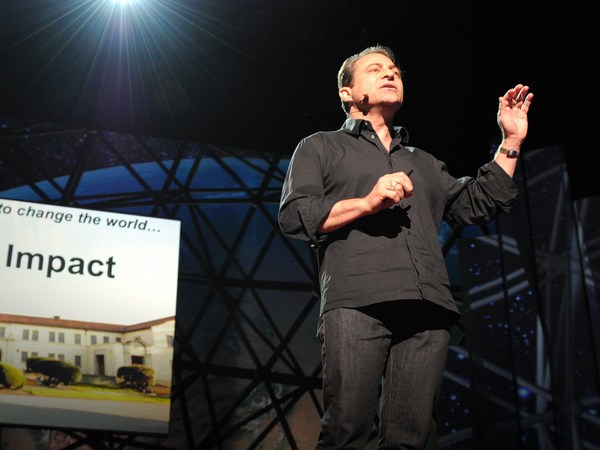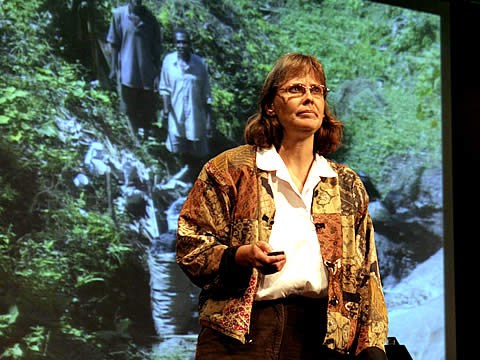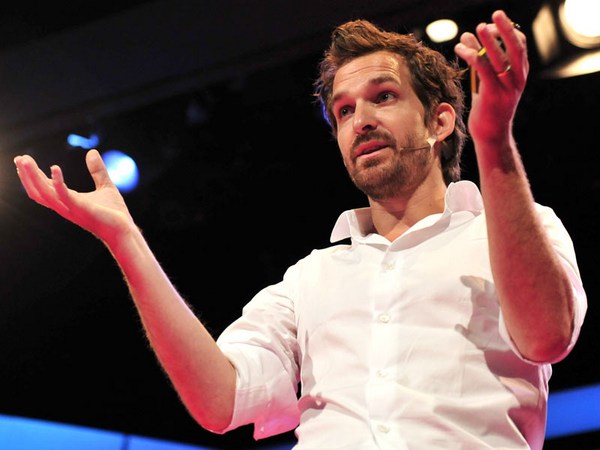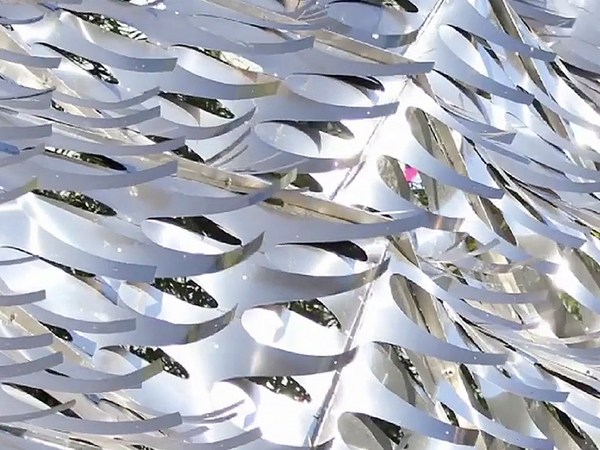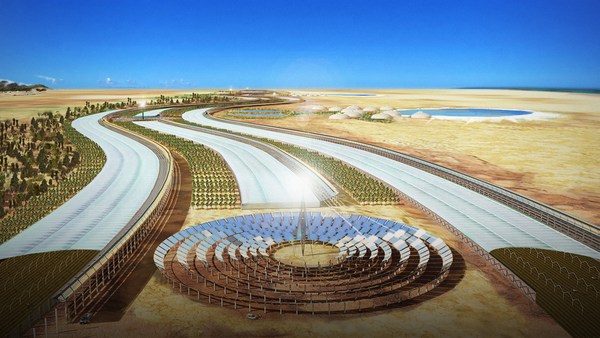Good evening.
We are in this wonderful open-air amphitheater and we are enjoying ourselves in that mild evening temperature tonight, but when Qatar will host the football World Cup 10 years from now, 2022, we already heard it will be in the hot, very hot and sunny summer months of June and July. And when Qatar has been assigned to the World Cup all, many people around the world have been wondering, how would it be possible that football players show spectacular football, run around in this desert climate? How would it be possible that spectators sit, enjoy themselves in open-air stadia in this hot environment?
Together with the architects of Albert Speer & Partner, our engineers from Transsolar have been supporting, have been developing open-air stadia based on 100 percent solar power, on 100 percent solar cooling.
Let me tell you about that, but let me start with comfort. Let me start with the aspect of comfort, because many people are confusing ambient temperature with thermal comfort.
We are used to looking at charts like that, and you see this red line showing the air temperature in June and July, and yes, that's right, it's picking up to 45 degrees C. It's actually very hot. But air temperature is not the full set of climatic parameters which define comfort.
Let me show you analysis a colleague of mine did looking on different football, World Cups, Olympic Games around the world, looking on the comfort and analyzing the comfort people have perceived at these different sport activities, and let me start with Mexico.
Mexico temperature has been, air temperature has been something between 15, up to 30 degrees C, and people enjoyed themselves. It was a very comfortable game in Mexico City. Have a look. Orlando, same kind of stadium, open-air stadium. People have been sitting in the strong sun, in the very high humidity in the afternoon, and they did not enjoy. It was not comfortable. The air temperature was not too high, but it was not comfortable during these games.
What about Seoul? Seoul, because of broadcast rights, all the games have been in the late afternoon. Sun has already been set, so the games have been perceived as comfortable.
What about Athens? Mediterranean climate, but in the sun it was not comfortable. They didn't perceive comfort.
And we know that from Spain, we know that "sol y sombra." If you have a ticket, and you get a ticket for the shade, you pay more, because you're in a more comfortable environment.
What about Beijing? It's again, sun in the day and high humidity, and it was not comfortable.
So if I overlay, and if you overlay all these comfort envelopes, what we see is, in all these places, air temperature has been ranging something from 25 to 35, and if you go on the line, 30, of 30 degrees C ambient temperatures. If you go along that line you see there has been all kind of comfort, all kinds of perceived outdoor comfort, ranging from very comfortable to very uncomfortable.
So why is that? This is because there are more parameters influencing our thermal comfort, which is the sun, the direct sun, the diffuse sun, which is wind, strong wind, mild wind, which is air humidity, which is the radiant temperature of the surroundings where we are in. And this is air temperature.
All these parameters go into the comfort feeling of our human body, and scientists have developed a parameter, which is the perceived temperature, where all these parameters go in and help designers to understand which is the driving parameter that I feel comfort or that I don't feel comfort. Which is the driving parameter which gives me a perceived temperature? And these parameters, these climatic parameters are related to the human metabolism.
Because of our metabolism, we as human beings, we produce heat. I'm excited, I'm talking to you, I'm probably producing 150 watts at the moment. You are sitting, you are relaxed, you're looking at me. It's probably 100 watts each person is producing, and we need to get rid of that energy. I need, with my body, to get rid of the energy, and the harder it is for myself, for my body, to get rid of the energy, the less comfort I feel. That's it. And if I don't get rid of the energy, I will die.
If we overlay what happens during the football World Cup, what will happen in June, July, we will see, yes, air temperature will be much higher, but because the games and the plays will be in the afternoon, it's probably the same comfort rating we've found in other places which has perceived as non-comfortable.
So we sat together with a team which prepared the Bid Book, or goal, that we said, let's aim for perceived temperature, for outdoor comfort in this range, which is perceived with a temperature of 32 degrees Celsius perceived temperature, which is extremely comfortable. People would feel really fine in an open outdoor environment.
But what does it mean? If we just look on what happens, we see, temperature's too high. If we apply the best architectural design, climate engineering design, we won't get much better.
So we need to do something active. We need, for instance, to bring in radiant cooling technology, and we need to combine this with so-called soft conditioning.
And how does it look like in a stadium? So the stadium has a few elements which create that outdoor comfort. First of all, it's shading. It needs to protect where the people are sitting against strong and warm wind.
But that's not all what we need to do. We need to use active systems. Instead of blowing a hurricane of chilled air through the stadium, we can use radiant cooling technologies, like a floor heating system where water pipes are embedded in the floor. And just by using cold water going through the water pipes, you can release the heat which is absorbed during the day in the stadium, so you can create that comfort, and then by adding dry air instead of down-chilled air, the spectators and the football players can adjust to their individual comfort needs, to their individual energy balance. They can adjust and find their comfort they need to find.
There are 12 stadia probably to come, but there are 32 training pitches where all the individual countries are going to train. We applied the same concept: shading of the training pitch, using a shelter against wind, then using the grass. Natural-watered lawn is a very good cooling source stabilizing temperature, and using dehumidified air to create comfort.
But even the best passive design wouldn't help. We need active system. And how do we do that?
Our idea for the bid was 100 percent solar cooling, based on the idea that we use the roof of the stadia, we cover the roofs of the stadia with PV systems. We don't borrow any energy from history. We are not using fossil energies. We are not borrowing energy from our neighbors. We're using energy we can harvest on our roofs, and also on the training pitches, which will be covered with large, flexible membranes, and we will see in the next years an industry coming up with flexible photovoltaics, giving the possibilities of shading against strong sun and producing electric energy in the same time.
And this energy now is harvested throughout the year, sent into the grid, is replacing fossils in the grid, and when I need it for the cooling, I take it back from the grid and I use the solar energy which I have brought to the grid back when I need it for the solar cooling. And I can do that in the first year and I can balance that in the next 10, and the next 20 years, this energy, which is necessary to condition a World Cup in Qatar, the next 20 years, this energy goes into the grid of Qatar.
So this -- (Applause)
Thank you very much. (Applause)
This is not only useful for stadia. We can use that also in open-air places and streets, and we've been working on the City of the Future in Masdar, which is in the United Emirates, Abu Dhabi. And I had the pleasure to work on the central plaza. And the same idea to use there, to create outdoor conditions which are perceived as comfortable. People enjoy going there instead of going into a shopping mall, which is chilled down and which is cooled. We wanted to create an outdoor space which is so comfortable that people can go there in the early afternoon, even in these sunny and hot summer months, and they can enjoy and meet there with their families. (Applause)
And the same concept: shade against the sun, shade against the wind, and use, use and take advantage of the sun you can harvest on your footprint. And these beautiful umbrellas.
So I'd like to encourage you to pay attention to your thermal comfort, to your thermal environment, tonight and tomorrow, and if you'd like to learn more about that, I invite you to go to our website. We uploaded a very simple perceived temperature calculator where you can check out about your outdoor comfort. And I also hope that you share the idea that if engineers and designers can use all these different climatic parameters, it will be possible to create really good and comfortable outdoor conditions, to change our thermal perception that we feel comfortable in an outdoor environment, and we can do that with the best passive design, but also using the energy source of the site in Qatar which is the sun.
(Applause)
Thank you very much. (Applause) Shukran. (Applause)
